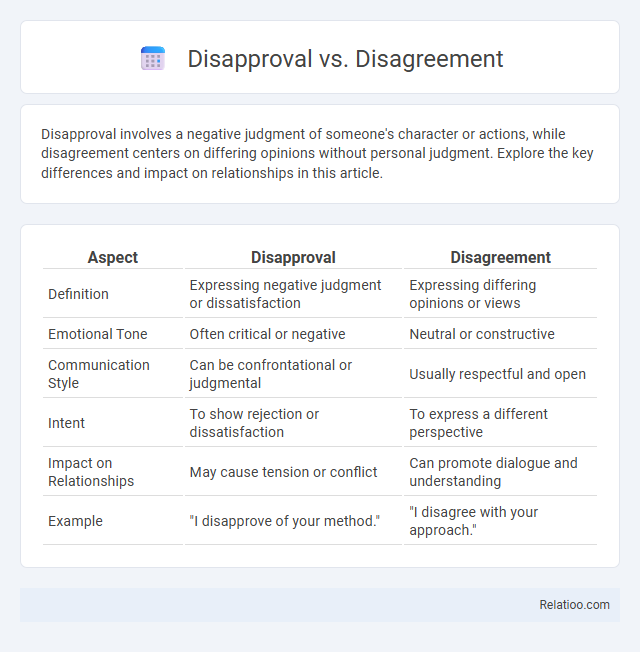Disapproval involves a negative judgment of someone's character or actions, while disagreement centers on differing opinions without personal judgment. Explore the key differences and impact on relationships in this article.
Table of Comparison
| Aspect | Disapproval | Disagreement |
|---|---|---|
| Definition | Expressing negative judgment or dissatisfaction | Expressing differing opinions or views |
| Emotional Tone | Often critical or negative | Neutral or constructive |
| Communication Style | Can be confrontational or judgmental | Usually respectful and open |
| Intent | To show rejection or dissatisfaction | To express a different perspective |
| Impact on Relationships | May cause tension or conflict | Can promote dialogue and understanding |
| Example | "I disapprove of your method." | "I disagree with your approach." |
Understanding Disapproval and Disagreement
Disapproval and disagreement often get confused but hold distinct meanings; disapproval reflects a negative judgment about someone's actions or ideas, while disagreement involves a difference in opinion without necessarily implying judgment. Understanding disapproval requires recognizing the emotional response tied to moral or ethical standards, whereas disagreement centers on conflicting viewpoints without emotional condemnation. Your ability to distinguish between these concepts enhances communication and helps address conflicts more effectively.
Key Differences Between Disapproval and Disagreement
Disapproval involves a negative judgment or moral objection to an action, while disagreement reflects a difference in opinion or perspective without necessarily involving judgment. Your response to disapproval often includes a sense of ethical critique, whereas disagreement centers on conflicting views or interpretations. Recognizing these nuances helps in effective communication and conflict resolution.
Emotional Reactions in Disapproval vs Disagreement
Disapproval often triggers stronger emotional reactions such as disappointment, frustration, or resentment, as it implies a moral or personal judgment against someone's actions or character. Disagreement tends to involve cognitive conflict focused on differing opinions or beliefs, usually without intensely negative emotions, allowing for constructive dialogue. Emotional responses in disapproval can hinder communication, while disagreement fosters analytical engagement and problem-solving.
The Role of Values and Beliefs
Disagreement arises when Your opinions or ideas contrast due to different perspectives, while disapproval stems from a negative judgment based on conflicting values and beliefs. Values serve as deeply held principles guiding what You consider acceptable, making disapproval more emotionally charged and rooted in moral or ethical frameworks. Understanding the distinction clarifies communication and fosters empathy when navigating conflicts driven by fundamental beliefs.
Communication Styles in Disapproval and Disagreement
Disapproval in communication often conveys a judgment or negative evaluation of someone's actions or ideas, typically expressed through tone, facial expressions, or direct statements, which can create defensiveness. Disagreement involves a difference of opinion or perspective, focusing on the content of the discussion rather than personal judgment, allowing for constructive dialogue and mutual understanding. Your ability to distinguish and express these styles effectively can enhance interpersonal communication and conflict resolution.
Social and Cultural Influences
Disapproval often stems from societal norms and cultural values that dictate acceptable behavior, influencing how communities judge actions or beliefs. Disagreement arises from diverse perspectives shaped by individual experiences and cultural backgrounds, reflecting varying interpretations rather than moral judgments. Your ability to navigate social interactions depends on understanding these distinctions, as disapproval impacts social acceptance while disagreement fosters dialogue and cultural exchange.
Impact on Relationships and Interpersonal Dynamics
Disapproval often leads to strained relationships due to its judgmental nature, signaling a breach in values or expectations, which can create defensiveness and distance. Disagreement, typically rooted in differing viewpoints or opinions, encourages dialogue and intellectual growth but can cause friction if not managed with respect and empathy. Dislike, as a more emotional response, impacts interpersonal dynamics by fostering avoidance or lack of trust, often undermining collaboration and mutual understanding.
How to Express Disapproval Constructively
Expressing disapproval constructively involves focusing on specific behaviors or outcomes rather than personal traits, which helps maintain respect and openness in the conversation. Using "I" statements, such as "I feel concerned when deadlines are missed," allows you to communicate your perspective without alienating others. This approach creates a space for dialogue, distinguishing your stance from mere disagreement or general disapproval by fostering understanding and potential solutions.
Navigating Healthy Disagreement
Navigating healthy disagreement involves recognizing the difference between disapproval and simple disagreement; disapproval carries a judgmental tone that can hinder constructive dialogue while disagreement reflects a difference in opinion without personal judgment. Your ability to separate these emotions fosters respectful communication, encourages openness, and promotes mutual understanding in conflicts. Emphasizing active listening and empathy turns disagreements into opportunities for growth and collaboration rather than sources of discord.
Finding Resolution: Bridging Disapproval and Disagreement
Disapproval often reflects a negative judgment about actions or ideas, while disagreement centers on a difference in opinion or belief. Finding resolution requires identifying common goals and fostering open communication to transform disapproval and disagreement into mutual understanding. Effective conflict resolution leverages empathy and active listening to bridge divides and promote collaborative solutions.

Infographic: Disapproval vs Disagreement
 relatioo.com
relatioo.com